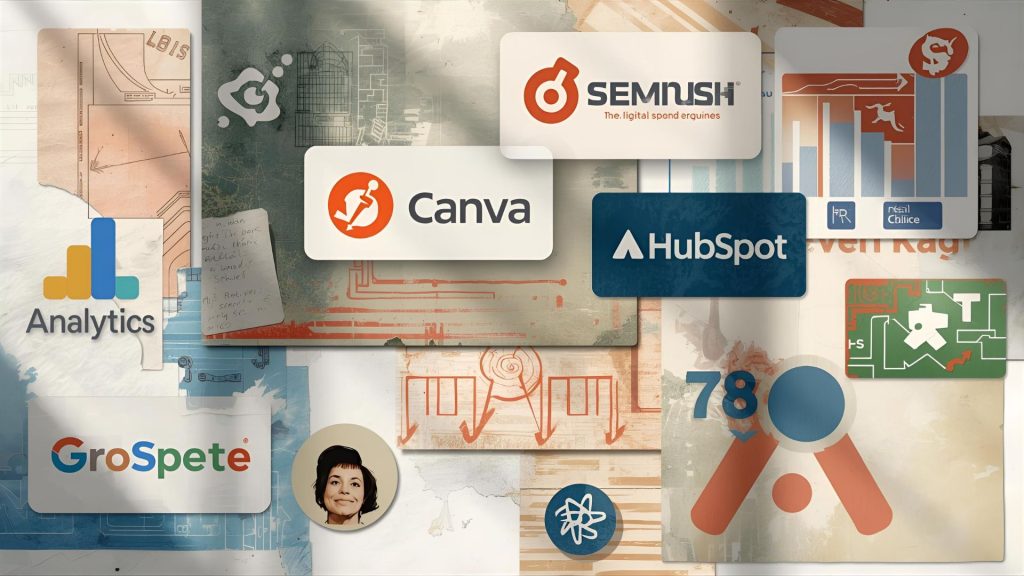Introduction
If you’re a student curious about digital marketing, you’ve probably heard about tools like Google Analytics, Canva, or SEMrush. At first, it feels overwhelming—so many platforms, endless tutorials, and a ton of advice. The big question is: which tools are actually worth learning as a beginner?
The truth is, digital marketing isn’t just about theory—it’s about using tools to put that theory into action. Whether you want to build a career in marketing, start your own venture, or simply boost your resume, the right tools can make all the difference.
This blog will walk you through some of the best tools for students to learn digital marketing. I’ll explain what each tool does, why it’s useful, and how you can start using it—even if you’re brand new.

Why Digital Marketing Tools Are Important for Students
Think of digital marketing tools like a carpenter’s toolbox. Sure, you can read about building a chair, but without the right hammer, saw, or drill, you’ll struggle.
In the same way, learning marketing concepts in class is great, but unless you practice with real tools, you won’t gain practical skills. And employers today want proof that you can actually do the work.
By exploring tools early on, you:
- Build job-ready skills
- Learn faster through hands-on practice
- Make your projects look more professional
- Gain confidence for internships and interviews
Now, let’s look at the tools that matter most.
Best Tools Every Student Should Try

1. Google Analytics
Google Analytics is like the heartbeat monitor of a website. It shows who’s visiting, where they came from, and what they’re doing on the site.
- Why learn it? Nearly every business uses it. If you can read and explain analytics, you’ll already be ahead of many applicants.
- Best feature: Real-time traffic updates—seeing visitors live on a site feels exciting!
2. SEMrush
This is one of the most popular SEO tools. It helps you find keywords, analyze competitors, and understand what’s working for them.
- Why learn it? SEO is a must-have skill. SEMrush makes learning keywords and backlinks simple.
- Best feature: The “Keyword Magic Tool” which gives beginner-friendly keyword ideas.
3. Canva
Designing used to mean hours on Photoshop. Not anymore. Canva makes creating posters, social posts, and presentations ridiculously easy.
- Why learn it? As a student, you’ll need visuals for projects, blogs, or campaigns. Canva makes you look like a designer without actually being one.
- Best feature: Ready-to-use templates for Instagram, LinkedIn, and more.
4. HubSpot Academy
HubSpot itself is a CRM platform, but the HubSpot Academy is where students should focus. It’s packed with free digital marketing courses.
- Why learn it? You get certified for free, and these certificates are recognized by recruiters.
- Best feature: Email marketing and inbound marketing lessons are perfect for beginners.
5. Mailchimp
Even with TikTok and Instagram dominating, email marketing still brings some of the best results for businesses. Mailchimp is the go-to platform to learn it.
- Why learn it? It’s beginner-friendly and teaches you how businesses connect with customers through email.
- Best feature: Automation workflows—you’ll see how emails are triggered automatically.
6. Hootsuite
If you’ve ever wondered how brands manage dozens of social media accounts at once, here’s the answer. Hootsuite helps schedule, monitor, and analyze posts.
- Why learn it? Social media management is one of the hottest skills.
- Best feature: The social media calendar—it makes planning posts way easier.
7. Yoast SEO
If you’re into blogging or content writing, Yoast SEO is a must-have WordPress plugin. It tells you whether your article is SEO-friendly while you’re writing it.
- Why learn it? It’s like having a personal editor checking your SEO.
- Best feature: The traffic-light system (green, yellow, red) that shows if your content is optimized.
8. Grammarly
Strong writing is at the heart of digital marketing. Grammarly ensures your work is error-free and professional.
- Why learn it? No one wants typos in an email campaign or blog. Grammarly saves you from embarrassment.
- Best feature: Tone detection—it helps you adjust your style depending on your audience.
How to Pick the Right Tools for Yourself
Here’s the good news: you don’t need to master all these tools at once. Start small.
- If you’re curious about SEO & data → try Google Analytics and SEMrush.
- If you love design & writing → start with Canva, Grammarly, and Yoast SEO.
- If you’re into campaigns & social media → focus on Mailchimp, Hootsuite, and HubSpot Academy.
Pick two or three, practice them consistently, and then expand your list as you grow.
Final Thoughts
Digital marketing is growing fast, and tools are the bridge between theory and real-world application. For students, learning even a few of these tools can boost your confidence, sharpen your resume, and open doors to internships and jobs.
Remember, most of these tools have free versions, and some (like HubSpot Academy or Google certifications) offer certificates that can really make your LinkedIn profile shine.
So, don’t wait for your first job to start practicing jump in now. The earlier you start, the faster you’ll grow.

FAQs
1. Which is the easiest tool for beginners?
Canva and Google Analytics are perfect starting points. One builds your design skills, the other introduces you to website data.
2. Do I need to pay for these tools?
Not at all. Most of them have free versions, which are more than enough for students.
3. Can these tools help me land a job?
Yes. Employers love practical skills, and tools like SEMrush, Mailchimp, and Hootsuite are widely used in companies.
4. How long does it take to learn?
Beginner tools like Canva or Grammarly take a week or two. Advanced ones like SEMrush may take a couple of months of practice.
5. Are certifications worth it?
Definitely. Free certificates from Google Analytics and HubSpot are highly valued and give you a competitive edge.
